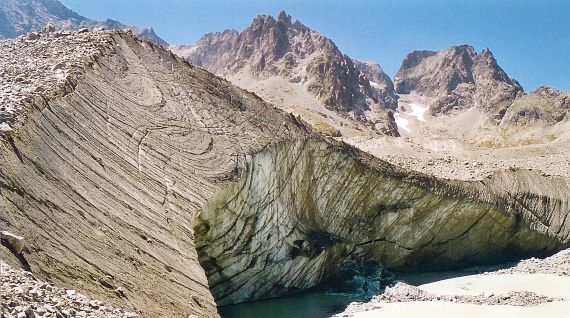Whether you’re climbing, hiking or caving, it’s hard to ignore the geology around you. For keen climber and environmental geoscientist Ivan Bour, a trip to the French Alps is no exception…
I’ve practiced mountain climbing for a dozen years. During my ascents, I seek geomorphological and geological peculiarities. Very often, I associate my profession as a geologist with my activities in the high mountains that allow me to capture new images of the Alpine peaks. This one captures the glacial curiosities of the southern French Alps.

“Syncline ice” by Ivan Bour, showing the deformation in synclinal structure of ice layers (Arsine glacier, 2500 m, Ecrins massif, Alps, France). This photo is distributed by the EGU under a Creative Commons licence.
The picture was taken on the Arsine glacier within the French Alps (northeastern edge of Ecrins massif, Ecrins National Park). This glacier begins on the slopes of a circus with a horseshoe form open northbound (which corresponds to a glacier circus). The glacier is dominated by a high wall of crystalline rocks oscillating between 3200 and 3600 meters over Agneaux peak, the Neige Cordier peak and Arsine peak. This wall is deeply lacerated by countless avalanche corridors that supply the glacier with packed snow and rock debris.
The amount of accumulating ice and the maintenance of the ice volume is related to the shelter phenomenon caused by the mountain barrier, which compensates for the relatively low average altitude of the glacial system (2731 m). The Arsine glacier is between 2450 and 3600 meters above sea level and is 1.7 km long. The glacier front takes the particular form of an ice cliff that plunges into a lake, fed by meltwater from the glacier. These waters are retained by the frontal and lateral moraines. The altitude of the glacier is very low in the circus, the erosion of the mountain barrier produced a steady dusting of heterogeneous rocks and these gneiss and granite blocks cover the surface of the ice. Its debris shell (approximately 5 to 10 m thick) preserves the glacier to climatic contrasts (summer seasons). In France, this type of glacier is called a black glacier.
This picture shows a close-up of the serac front (formed when crevasses on a glacier meet) observed from the medial moraine. The gray waves of the ice cliff are small rocky debris deposits, which are interspersed between ice layers. The layers show periods of ice formation (winter-spring) alternating with periods of debris accumulation (summer-autumn). The moraine surface is a carpet of rocks that obscures the surface of the glacier. Modern ice shows a beautiful syncline of successive layers whose axis is the centre of channel flow. The syncline you see here is a consequence of the ice flow, as the glacier adapts to the shape of the flow circus (depression of the centre and compression of the sides). The ice layers are accumulated in a wide V, and then compressed during the flow downstream. The serac front is continually evolving and undergoes flaking processes that quickly change the morphology of the glacier in the downstream zone. The increasing average temperatures experienced in this regoin are accelerating this process.
By Ivan Bour, Université de Bourgogne
Imaggeo is the EGU’s online open access geosciences image repository. All geoscientists (and others) can submit their images to this repository and since it is open access, these photos can be used by scientists for their presentations or publications as well as by the press and public for educational purposes and otherwise. If you submit your images to Imaggeo, you retain full rights of use, since they are licensed and distributed by the EGU under a Creative Commons licence.
